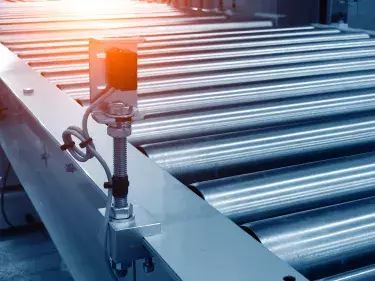What is a Spiral Conveyor Belt?
A spiral conveyor belt, also known as a spiral conveyor or spiral elevator, is a type of conveyor system used to transport materials or goods vertically in a continuous manner.
A spiral conveyor is a common sight in many production environments including food and beverage, pharmaceutical, manufacturing and logistics. Spiral conveyor belt systems are used to move products up and down between different levels of a production plant and offer a space-saving method of increasing production throughput.
How does a Spiral Conveyor Belt work?
The conveyor belt is designed in the form of a helix or spiral, resembling a large screw or coil. The belt is usually made of a durable and flexible material like plastic or steel to support the load and withstand the twisting motion. THis is powered by an electric motor and drive system, located at the base or top of the structure. The motor drives the belt, causing it to rotate along the helical path.
At the bottom or starting point of the conveyor, the materials are fed onto the belt. This can be done manually or by integrating the spiral conveyor with other equipment, such as feeding systems or production lines.
As the belt rotates, the helical structure gently lifts the materials along the spiral path. The incline and pitch of the spiral determine the vertical movement of the materials.
Spiral conveyors can have either an upward or downward configuration, depending on the application and space constraints. In upward configurations, the materials are conveyed to a higher level, while in downward configurations, they are brought down to a lower level.
The helical design ensures a smooth and continuous flow of materials without any sudden drops or jolts. This gentle handling is particularly useful for delicate or fragile items that need to be transported without damage.
At the top or end point of the conveyor, the materials are unloaded from the belt. Again, this can be done manually or integrated with other equipment to transfer the materials to the next stage of the process or production line.
What are the common issues with Spiral Conveyor Belts?
Because the belt in a spiral conveyor needs to follow a curved path as well as a straight path, it’s common for the belt to develop high levels of tension, which can cause it to buckle or even break, disrupting production.
Belt Tracking Problems
Spiral conveyor belts need to be aligned correctly to prevent tracking issues. If the belt is not properly tensioned or if there is damage to the belt or guiding system, it can lead to misalignment. Belt tracking problems can cause uneven wear on the belt, reduce efficiency, and potentially lead to damage.
Wear and Tear
Over time, the constant rotation and movement of the belt can cause wear and tear. This may lead to fraying, cracks, or weakened sections in the belt material. Regular maintenance and inspections are essential to identify and address such issues promptly.
Belt Slippage
In some cases, especially when dealing with heavier loads or steep inclines, the belt may experience slippage. This can be due to insufficient friction between the belt and the drive system or excessive loads beyond the conveyor's capacity.
Belt Deformation
If the spiral conveyor is not properly designed or if it is subject to excessive loads, the belt may deform or become misshapen. This can result in an uneven spiral path, leading to poor material transport.
Inadequate Maintenance
Regular maintenance is crucial to ensure the smooth functioning of the spiral conveyor system. Failing to perform routine checks, lubrication, and repairs can lead to more significant problems down the line
How do Strain Gauges solve these problems?
Custom strain gauges can be employed to monitor and address some of the common issues that can occur with spiral conveyor belt systems. Strain gauges are sensors that measure the deformation (strain) of an object under applied forces. By attaching strain gauges to key components of the conveyor system, you can gather data that helps identify problems and optimize the system's performance. Here's how custom strain gauges can be used to address the issues mentioned earlier.
At HITEC, we solve our customers problems with intelligent, custom solutions. We are able to design and implement a wireless load sensing link as part of the spiral conveyor belt system and monitoring belt tension. This wireless load sensing link can be completely customized to seamlessly fit into an existing system. Furthermore there are many benefits to using a wireless sensing link within an environment with a lot of moving parts, such as a conveyor belt system.
Once installed into a conveyor belt system, our sensors perform non-stop diagnostics and accurately schedule preventative maintenance for cleaning and sanitation. Resulting in increased belt life, reduced downtime, and reduced risk of sudden unexpected production stops, all of which contributes to increased productivity and reduced operating costs.


